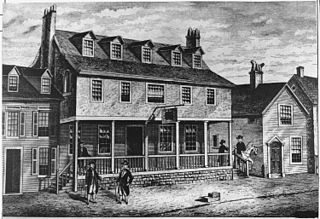
As noted in the first installment, eighteenth century American taverns were a necessary community institution — a place where travelers and residents could grab a meal, read the newspaper, or conduct business. In appearance, taverns looked much like a large house with chimneys at either end.
The ground floor and primary place of business featured a large taproom furnished with chairs, tables, a bar in the corner, and a large fireplace that took up most of one wall. Some had parlors attached for private events or dining. The kitchen was in the back room where cooks turned out various meals.
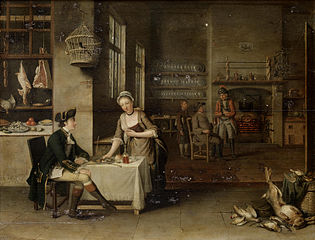
A full New England breakfast included ham, beef, sausages, pork, bread, butter, boiled potatoes, pies, coffee, cider.
Ezra Beaman, a tavern keeper in West Boylston, Massachusetts noted his food purchases of beef, veal, pork, occasionally turkey, and lots of chicken. Sometimes there was salt haddock, shad, or codfish brought in from Boston. Beaman’s wife and kitchen staff transformed the food into steaks, chops, roasts, boiled dinners, and stews. He also bought fresh & dried apples for pies at breakfast & dinner, bread, potatoes, beans, root vegetables, and salad greens.
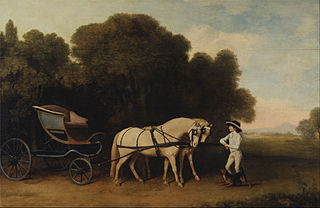
The second floor generally had rooms to rent to travelers. Distances might seem short to us, but any destination more than ten miles away required overnight accommodation for guests and their horses. Williamsburg tavern keeper Grissel Hay advertised her “very commodious lodgings to let for a dozen gentlemen, their servants, with stables & provisions for their horses.”
Regarding the stage journey from Boston to New York in 1783, Josiah Quincy noted: “the journey to NY from Boston took up a week. The carriages were old and shackling, and much of the harness made of ropes. One pair of horses carried the stage 18 miles. We generally reached our resting place for the night, if no accident intervened, at 10:00, and after a frugal supper went to bed, with a notice that we should be called at 3 the next morning, which generally proved half past 2.”
I’m not sure travelers had time to indulge, but popular beverages included strong beer, ale, cider, rum, port wine, Madeira wine, ruby red clarets, and brandy beverages. Mixed refreshments of punch and flip were popular choices. Flip was an American drink made in pitchers and particularly popular in colder weather.
To make flip, fill two-thirds of a pitcher with strong beer and rum sweetened with sugar, molasses, or dried pumpkin. Next, plunge a red hot iron loggerhead into the mixture. This produces foam and gives the drink a burnt, bitter taste. Sometimes nutmeg was added before serving. Though this recipe doesn’t mention it, an egg was often added.
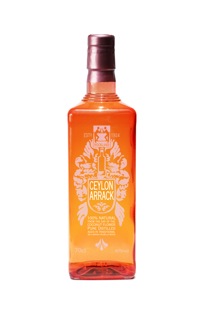
Punch originated in China and the East Indies. A 1771 recipe prescribes: “to a quart of boiling water, half a pint of arrack is taken, to which one pound of sugar and five or six lemons, or instead as many tamarinds as are necessary to give it the true acidity, are added: a nutmeg is likewise grated into it.”
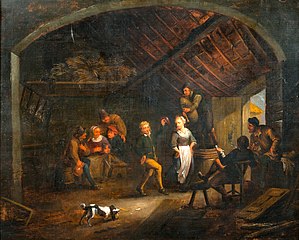
Arrack, by the way, was a distilled beverage made from the fermented sap of coconut flowers or sugar cane and a grain such as red rice. Batavia Arrack is a clear liquid that tastes similar to dark rum; Ceylon Arrack is more subtle with hints of rum and cognac.
After indulging in food and drink, a fiddler might encourage dancing. Fistfights might break out, though this was not encouraged. During the winter, there was indoor target shooting.
During longer evenings, outside activities included cricket or quoits. Nine pins, an early form of bowling, could be played in a nearby side alley or lane. There was also cockfighting.
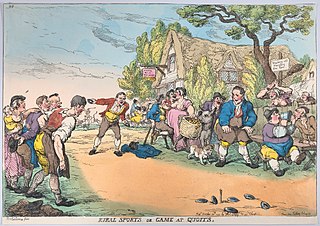
John Adams, who often stopped at roadside taverns observed, “if you sit the evening you will find the house full of people drinking drams, flip, toddy, carousing, swearing, but especially plotting with the landlord to get him at the next town meeting an election either for selectman or representative.”
By the late eighteenth century other entertainments such as plays, concerts, exhibitions, and assembly dances became available. But the tavern retained its place as a center of community life.
🍺 🍺 🍺
Illustrations
The Old Tun Tavern, Philadelphia.
Tavern Interior by John S C Schaak, 1762.
Phaeton with a pair of Cream Ponies & a Stable Lad by George Stubbs, about 1780.
Contemporary bottle of Rockland Ceylon Arrack.
From the Tavern, Unknown Artist.
Game of Quoits by Thomas Rowlandson.
Jared unt Anistatia. “Lost Ingredients: Arrack.” Mixology. April 28, 2014.
Sarah Hand Meacham. “Keeping the Trade: The Persistence of Tavern-keeping among Middling Women in Colonial Virginia.” Early American Studies, Spring 2005. Vol 3, No 1. Pp 140-163.
Steven Struzinski. “The Tavern in Colonial America.” The Gettysburg Journal. 2002.

Sandra Wagner-Wright holds the doctoral degree in history and taught women’s and global history at the University of Hawai`i. Sandra travels for her research, most recently to Salem, Massachusetts, the setting of her new Salem Stories series. She also enjoys traveling for new experiences. Recent trips include Antarctica and a river cruise on the Rhine from Amsterdam to Basel.
Sandra particularly likes writing about strong women who make a difference. She lives in Hilo, Hawai`i with her family and writes a blog relating to history, travel, and the idiosyncrasies of life.

